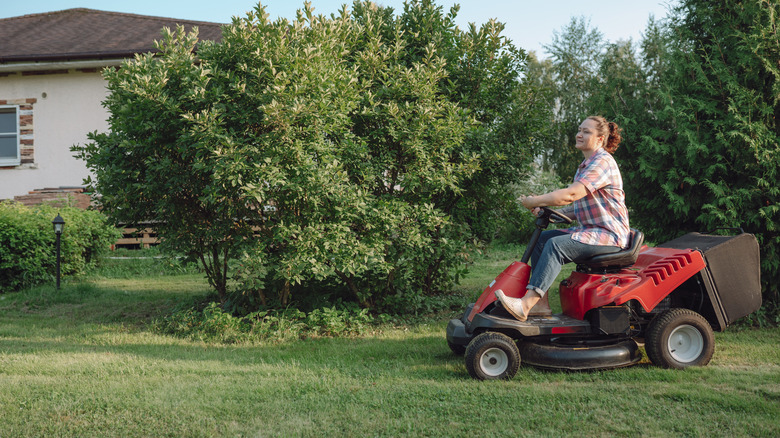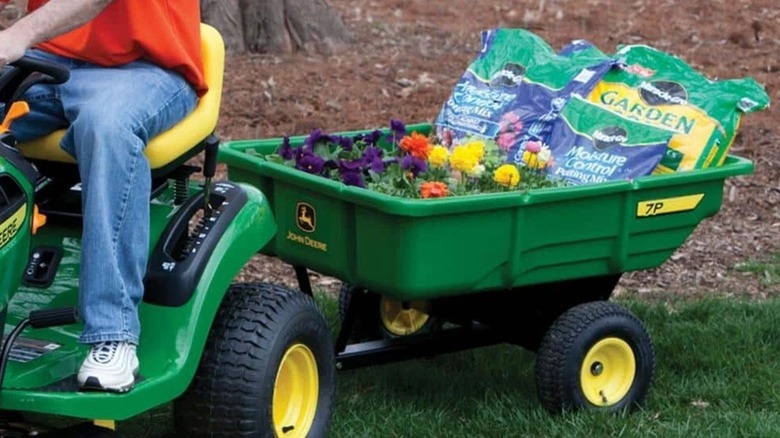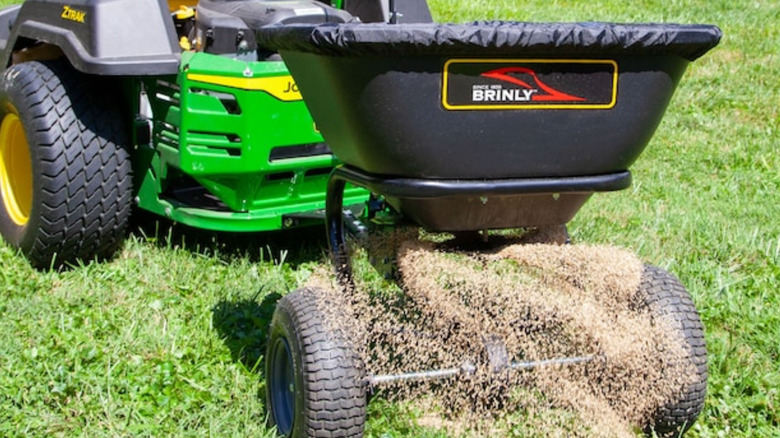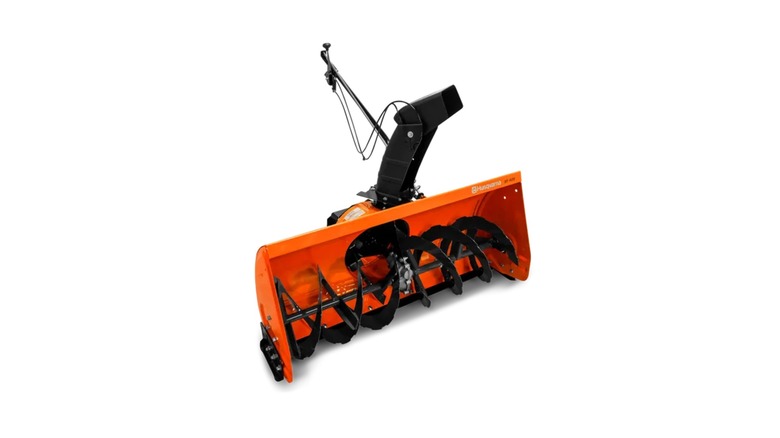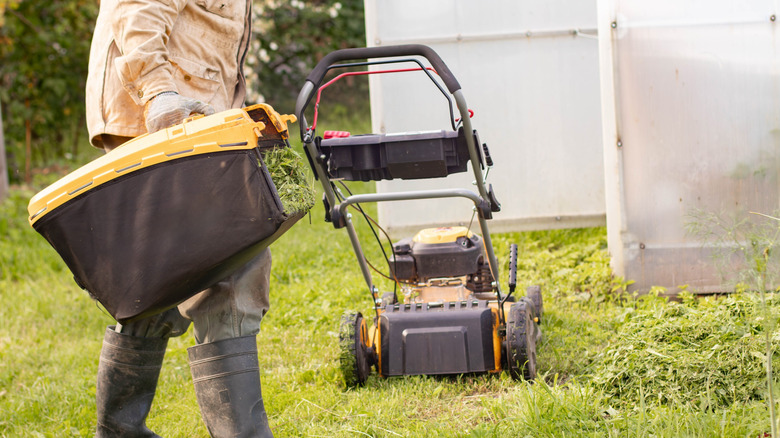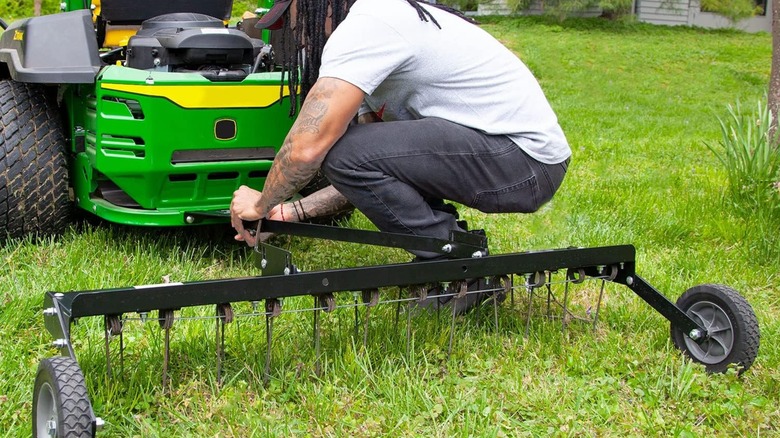5 Of The Best Mower Attachments To Save You Time In The Yard
We may receive a commission on purchases made from links.
Your lawn mower is a crucial piece of equipment, as caring for a large lawn without it is much more difficult. Many homeowners have already invested in standard lawn mowers, featuring push-behind functionality and perhaps even a self-propelled mode to make cutting the grass easier (and getting into tight corners less of a hassle). Others break out the lawn tractor to trim their yard, transforming the job into an operation that features far less physical labor and can be done much faster.
Regardless of which kind of lawn mower you haul out of the garage on a regular basis, there are a number of universal truths that factor into your task. Sharpening your lawn mower blades, for instance, should be done twice during the cutting and mowing season. There are other important factors involved in maintaining your lawn mower, of course, but it might also be worth your time to explore additional functions that the mower can perform. Additional mower attachments can transform a job traditionally reliant on hand tools into simpler and faster tasks that save you plenty of effort. Here are some attachments you might want to consider.
Utility carts
Possibly the most self-evident accessory attachment you might consider for your lawn mower is a utility cart. On a riding tractor-style mower, the utility cart can provide towing capabilities as you meander around the yard. People working in agricultural settings can gain significant use out of this addition, but even suburban riding mower users who have medium or even small garden spaces can benefit from having a cart.
This kind of accessory can replace your wheelbarrow, but that doesn't fully explain how useful this thing is. Anyone who's done yard maintenance and pushed a wheelbarrow around will know that this isn't exactly an easy task. The wheelbarrow is a tool that quickly becomes heavy, and keeping it moving while you heave a full load from one place to the next requires at least a moderate level of strength.
If you often find yourself hauling heavy material like topsoil, mulch, or gravel in a wheelbarrow, a utility cart is a must. Attaching it to the back of your riding lawn mower turns it into a towing vessel that supports these tasks with carefree ease. Utility carts tend to feature much larger load capacities than what the average person can move on their own, and your mower can certainly move faster than your legs can carry a loaded wheelbarrow.
Tow-behind spreaders
Spreaders are available at just about any home improvement store and in many varieties, including a high-tech power tool version by Ryobi. These spreading tools are fairly easy to use, but more professional alternatives dwarf their usefulness. Anyone with a large lawn will likely want to invest in a spreader that you can push instead of a handheld option. These tend to feature larger hoppers and provide a throwing range across a larger area.
There's another solution that increases your productivity even more than a push spreader: a tow-behind spreader. The improved functionality and size make this a much more powerful tool for landscaping that requires fewer passes across your lawn and finishes the job at a faster pace. Moreover, with increased capacity comes a lighter requirement to refill the spreader.
Towable spreaders can be used to distribute grass seed or even other wide-area planting coverage, but they can also spread fertilizer across the grass or top dress your lawn with a layer of new soil. Moving away from the handheld spreader that most will be familiar with allows you to speed up much of your routine landscaping tasks.
Snowblowing attachents
This lawn mower accessory covers a job that isn't usually necessary during the mowing season, and might make a surprise addition to your collection. And while it might look like a situational tool, it's actually quite versatile.
Many residents of northern regions will be intimately familiar with the snow shovel, and might already have a snow blower from a major brand. This tends to be a tool that you have to push along to fire snow off a walkway or driveway, but if you have a ride-on lawn mowers, you could get something even better: a snow-moving tool that you don't have to physically push around.
Driving your lawn mower along with a snow blower attachment installed allows you to minimize the physicality of the task and speed up the process by a significant margin. For those who live in areas that receive significant snowfall, discovering this additional use for your lawn mower can even be the impetus to make a change from a standard push mower to a riding mower, in order to get year-round value out of the tool.
Lawn mower baggers
Many homeowners collect grass clippings and leaves as they go about their mowing tasks. The collection bag is a common sight on push mowers, and plenty of weekend mowing jobs end with a user dumping this bag into a compost bin or some kind of grass collection area to use as an organic top dressing in garden beds and elsewhere. Many others don't use a collection bag at all and allow the grass clippings to simply fall onto the lawn where they are cut.
Depending on the type of grass you have and the frequency of your cutting, this can be problematic. Clumped grass clippings can weigh heavily on the lawn and potentially spell problems for healthy growth after you mow. Generally speaking, it's a good idea to bag the grass clippings you create, even if you're just going to throw them away. Whether on a riding mower or a push mower, a collection bag is a great accessory that should always be ready to use.
Essentially, this tool transforms your mower into something of a vacuum. Rather than simply cutting and tossing grass clippings, your mower will suck them up and catch most of the cut grass. This allows you to take it away and dispose of the waste as you see fit. No matter how you intend to deal with the clippings, leaving it to sit on the lawn because you haven't used a bagger is usually the worst approach.
Dethatchers
Your lawn naturally creates what is known as a thatch layer between the upper grass shoots and the roots down beneath the surface. This includes dead organic material, semi-broken down leaves, and other naturally occurring features of a healthy yard. The thatch layer can become too dense, leading to problems in drainage that keep your upper grass segment soggy while preventing the roots from receiving the water they need to keep the whole system thriving.
Dethatching is a task that should be a high priority for homeowners of all types. Generally, this is best done when the thatch layer grows to roughly 3/4 of an inch. It's best to occasionally dig up a small chunk of grass to examine this layer. You might find dethatching to be necessary every few years or on a much more regular basis depending on many factors, like where you live and what kind of grass you have growing.
The trouble with dethatching is that it's a backbreaking process that typically involves heavy raking. Just a small amount of raking can send your arms and back into agony, especially for older homeowners. This is what makes a dethatcher a great accessory to bring into your garage. There are versions of this tool that can be attached to a riding mower, and others that act as blade replacements for a push mower. This tool allows you to simply drive or push the mower around the lawn to perform what would otherwise be a lengthy and physically demanding day of work in the yard.
